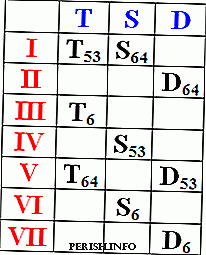 The main triad of frets is those triads that identify a given mode, its appearance and its sound. What does it mean? We have two main frets - major and minor.
The main triad of frets is those triads that identify a given mode, its appearance and its sound. What does it mean? We have two main frets - major and minor.
So, it is precisely because of the major sound of a triad that we understand that we are dealing with a major and by minor sound of a triad we define by ear a minor. Thus, the main triads in the major are major triads, and in the minor - obviously, minor.
Triad in fret are built on any step - only seven of them (seven steps), but the main triad of frets of them are only three - those that are built on the 1st, 4th and 5th steps. The remaining four triads are called side, they do not identify this mode.
Let's check these statements in practice. In the keys of C major and C minor, we will build triads on all steps (read the article “How to build a triad?”) And see what happens.
First in C major:

As we see, really - major triads are formed only on the I, IV and V steps. On the II, III and VI steps, triad minor minor form. And the only triad on the seventh degree is the diminished.
Now in C minor:

Here on the I, IV and V steps - on the contrary, minor triads. On the III, VI and VII steps - major (they are no longer an indicator of the minor mode), and on the II stage there is one reduced resistance.
What are the main triads fret?
By the way, the first, fourth and fifth steps are called "main steps of the mode" precisely because they are built on the main triad of frets.
As you know, all the steps of the mode have their functional names and the 1st, 4th and 5th here are no exception. The first step of the mode is called "tonic", the fifth and fourth - respectively, the "dominant" and "subdominant". The triads that are built on these steps take on their names: tonic triad (from the 1st step), subdominant triad (from the 4th step), dominant triad (from the 5th step).
Like any other triads, triads, which are built on the main steps, have two appeals each time (sektakkord and kvartsekstakakkord). For the full name, two elements are used: the first is the defining functional affiliation (tonic or tonic, subdominant or subdominant, dominant or dominant), and the second is the one that denotes the kind of chord structure (triad this or one of his references sekstakkord, kvartsekstakkkord).

 At what steps are the main triad appeals being built?
At what steps are the main triad appeals being built?
It's all quite simple - there is not even a need to explain something further. You do remember that any reversal of a chord is formed when we move up to the octave upwards to its lower sound, yes? So, this rule is also valid here.
In order not to calculate each time at which level a particular treatment is built, simply redraw the presented table in which you have all this into your workbook. By the way, there are other solfegio tables on the site - look, something can come in handy.
Main triads in harmonic frets
In harmonic modes with some steps, something happens. What? If you do not remember, let me remind you: in harmonic minors, the last, seventh steps are raised, and in harmonic majors, the sixth steps are lowered. These changes are reflected in the main triads.
Thus, in the harmonic major, due to a change in the sixth step, subdominant chords acquire a minor coloration and become downright minor. In the harmonic minor due to a change in the VII stage, on the contrary, one of the triad — dominant — becomes major in its composition and sound. An example in D major and D minor:

That's all, thank you for your attention! If you still have questions, ask them in the comments. If you want to keep the material on your page in contact or in classmates, use the block of buttons, which is under the article and at the very top!

 At what steps are the main triad appeals being built?
At what steps are the main triad appeals being built?
Leave Your Comment